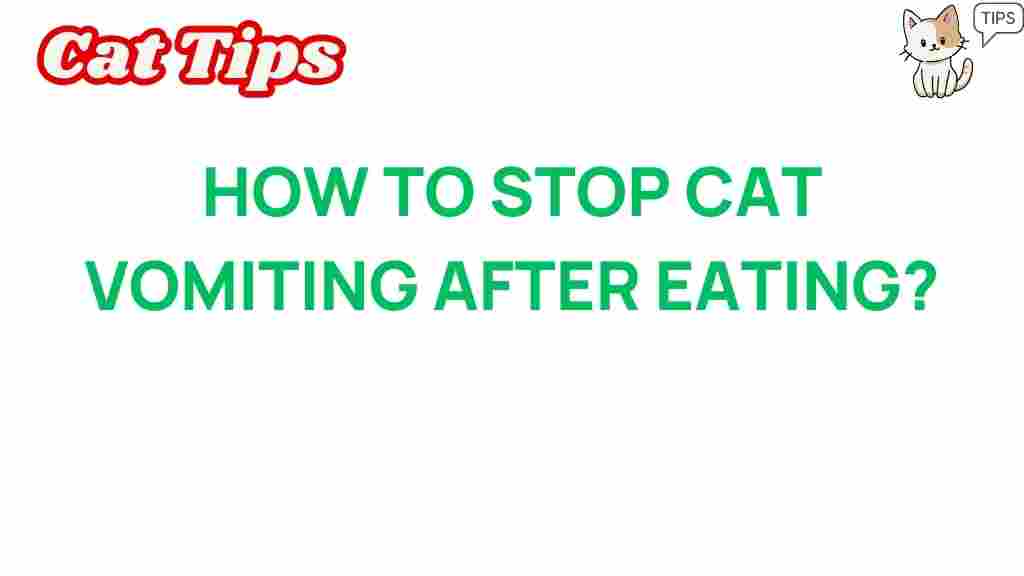Unlocking the Mystery: How to Stop Cat Vomiting
As a cat owner, few things are as distressing as watching your feline friend vomit after a meal. While occasional cat vomiting can be normal, frequent incidents can signal underlying health issues or dietary problems. Understanding the causes and knowing how to address them can help you ensure your cat leads a healthy, comfortable life. In this article, we’ll delve into the common reasons for cat vomiting, offer solutions, and provide troubleshooting tips to help you tackle this frustrating problem.
Understanding Cat Vomiting
Before we dive into solutions, it’s crucial to understand what cat vomiting really means. Vomiting is the forceful expulsion of the contents of a cat’s stomach. Unlike regurgitation, which is the passive expulsion of food, vomiting is an active process that can point to various health issues.
- Dietary Indiscretion: Cats are known for their curious nature and may eat something that doesn’t agree with them.
- Food Sensitivities: Some cats may have allergies or sensitivities to certain ingredients in their food.
- Rapid Eating: Cats that eat too quickly may vomit due to the sudden influx of food.
- Hairballs: Especially in long-haired breeds, hairballs can lead to vomiting.
- Underlying Health Issues: Conditions such as gastrointestinal diseases, infections, or metabolic disorders can cause vomiting.
Identifying the root cause of your cat’s vomiting is essential for determining the most effective solution. Let’s explore how to address cat vomiting based on these causes.
Step-by-Step Process to Stop Cat Vomiting
Once you’ve identified potential causes, you can take steps to reduce or eliminate cat vomiting. Here’s a guide to help you:
1. Monitor Food Intake
Keep track of what your cat eats and when it vomits. This information can help you identify patterns. Consider the following:
- Is your cat eating too quickly?
- What brand and type of food are you using?
- Are there any recent changes in diet?
2. Choose the Right Food
Selecting high-quality cat food is crucial. Look for options that are:
- Free from artificial additives
- Formulated for your cat’s specific needs (age, health status, etc.)
- Contain protein sources your cat hasn’t shown sensitivity to
Consider trying a limited-ingredient diet to rule out food sensitivities. Consult your vet for recommendations on the best food for your cat.
3. Slow Down Eating
If your cat tends to eat too quickly, consider using a slow feeder or puzzle toy. These tools can help your cat eat at a more moderate pace, reducing the likelihood of vomiting.
4. Stay Hydrated
Ensure your cat is drinking enough water. Dehydration can exacerbate vomiting. If your cat is reluctant to drink, try:
- Offering fresh, filtered water.
- Adding water to dry kibble.
- Using a cat water fountain to entice drinking.
5. Regular Grooming
For cats prone to hairballs, regular grooming can help reduce the amount of hair they ingest. Brushing your cat daily can significantly decrease shedding and hairball formation.
6. Provide a Calm Eating Environment
Reduce stress around mealtime. Make sure your cat has a quiet, comfortable space to eat without interruptions from other pets or loud noises.
7. Consult Your Veterinarian
If vomiting persists despite these changes, it’s vital to consult your veterinarian. They may recommend diagnostic tests to rule out underlying health conditions. Keep in mind that some health issues require immediate attention.
Troubleshooting Tips for Cat Vomiting
If you’ve implemented the above steps and your cat is still vomiting, consider the following troubleshooting tips:
Identify Stressors
Emotional and environmental stress can lead to vomiting in some cats. Pay attention to any changes in their environment, such as new pets, changes in routine, or loud noises.
Check for Other Symptoms
Monitor your cat for other signs of illness, such as:
- Diarrhea
- Lethargy
- Loss of appetite
- Excessive grooming or hair loss
Document these symptoms and share them with your veterinarian for better diagnosis.
Consider a Change in Diet Gradually
If you suspect your cat has food sensitivities, introduce new food gradually. Sudden changes can upset their digestive system and lead to more vomiting. Aim for a transition period of at least one week.
Limit Treats
While treats can be a great way to bond with your cat, too many can upset their stomach. Limit treats to no more than 10% of their daily caloric intake.
Keep an Eye on Hairballs
If hairballs are frequent, consider using hairball control treats or supplements. These can help pass hair through the digestive system more effectively.
When to Seek Immediate Veterinary Care
While many instances of cat vomiting can be managed at home, certain situations require immediate veterinary care. Seek help if your cat:
- Vomits repeatedly (more than twice in a day)
- Shows signs of pain or distress
- Has a swollen abdomen
- Is lethargic or unresponsive
- Vomits blood or has a strange color to the vomit
In these cases, it’s better to err on the side of caution and have your cat examined by a professional.
Conclusion
Cat vomiting can be concerning, but understanding the reasons behind it can empower you as a pet owner. By monitoring your cat’s eating habits, choosing the right food, and implementing strategies to slow down their eating, you can significantly reduce the occurrence of vomiting. If problems persist, don’t hesitate to consult your veterinarian for further guidance.
For more resources on cat care and health, check out this helpful guide. Remember, your cat’s health is paramount, and regular veterinary visits can ensure your furry friend stays happy and healthy.
By unlocking the mystery of cat vomiting, you can help your beloved pet enjoy a more comfortable and fulfilling life!
This article is in the category Health and created by CatTips Team
